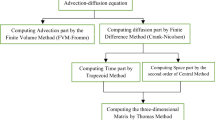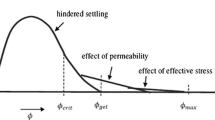Abstract
The settling process of cohesive sediment particles exists universally in nature and many engineering fields. Some of them have negative impacts, e.g., leading to the storage loss of reservoir, prolonging the duration of the reclamation project. Thus, understanding and quantifying cohesive sediments settling and flocculation processes are of great importance. In the present work, a three-dimensional model is applied to investigate the cohesive settling process numerically by computational fluid dynamics–discrete element method (CFD–DEM) approach. In the model, the cohesiveness of the sediment particle is modeled by implementing the van der Waals force. The simulation results are in good agreement with the experimental results, which demonstrate the ability of the current model to study the settling and flocculation process. For cohesive particles, the influence of polydispersity on structural density is discussed in two aspects: (a) the particle mean diameter d50 and (b) the geometric standard deviation d85/d15. Furthermore, the results show that the influence of these two parameters is more profound when a large Hamaker constant is applied. We also study the relationship between the maximum value of structural density and the Hamaker constant. The structure density is found to be significantly influenced by Hamaker constant when Hamaker constant is smaller than \(2.0\, \times \,10^{ - 20} \,{\text{J}}\). Besides, for the poly-dispersed system, different from non-cohesive particles, the segregation phenomenon is not obvious for poly-dispersed cohesive particles due to the flocculation phenomenon. Moreover, the excessive pore pressure in sediment bed does not dissipate instantaneously as the non-cohesive sediment bed. And with the increase of the Hamaker constant, the excessive pore pressure dissipation velocity of the sediment bed decreases. In this work, we study the flocculation phenomenon of cohesive particles. It’s found that the influence of cohesive force is more significant on small particles. Since with the reduction of the particle size, the inertial force decreases to a greater extent compared to the cohesive force, the particles’ motion is mainly determined by the cohesive force.



















Similar content being viewed by others
References
Berlamont, J., Ockenden, M., Toorman, E., Winterwerp, J.: The characterization of cohesive sediment properties. Coast. Eng. 21(1–3), 105–128 (1993). https://doi.org/10.1016/0378-3839(93)90047-C
Winterwerp, J.C.: On the dynamics of high-concentrated mud suspensions. Ph.D. Thesis, Delft University, Delft, Netherlands, pp. 79–81 (1999)
Bartholomeeusen, G., Sills, G.C., Znidarcic, D., Van Kesteren, W., Merckelbach, L.M., Pyke, R., Carrier, W.D., Lin, H., Penumadu, D., Winterwerp, H., Masala, S., Chan, D.: Sidere: numerical prediction of large-strain consolidation. Geotechnique 52(9), 639–648 (2002)
Zhang, F.H., Guo, S.J., Wang, B.T.: Experimental research on cohesive sediment deposition and consolidation based on settlement column system. Geotech. Test. J. 37(3), 548 (2014). https://doi.org/10.1520/gtj20130054
Townsend, F.C., Mcvay, M.C.: SOA—large strain consolidation predictions. J. Geotech. Eng. ASCE 116(2), 222–243 (1990). https://doi.org/10.1061/(Asce)0733-9410(1990)116:2(222)
Camenen, B., van Bang, D.P.: Modelling the settling of suspended sediments for concentrations close to the gelling concentration. Cont. Shelf Res. 31(10), S106–S116 (2011). https://doi.org/10.1016/j.csr.2010.07.003
Nguyen, K.D., Guillou, S., Chauchat, J., Barbry, N.: A two-phase numerical model for suspended-sediment transport in estuaries. Adv. Water Resour. 32(8), 1187–1196 (2009). https://doi.org/10.1016/j.advwatres.2009.04.001
Chauchat, J., Guillou, S., Bang, D.P.V., Nguyen, K.D.: Modelling sedimentation-consolidation in the framework of a one-dimensional two-phase flow model. J. Hydraul. Res. 51(3), 293–305 (2013). https://doi.org/10.1080/00221686.2013.768798
Xu, C.Y., Dong, P.: Two-phase flow modelling of sediment suspension in the Ems/Dollard estuary. Estuar. Coast. Shelf Sci. 191, 115–124 (2017). https://doi.org/10.1016/j.ecss.2017.04.011
Zhang, J.F., Zhang, Q.H.: Lattice Boltzmann simulation of the flocculation process of cohesive sediment due to differential settling. Cont. Shelf Res. 31(10), S94–S105 (2011). https://doi.org/10.1016/j.csr.2010.03.009
Xu, H.B., Zhong, W.Q., Yuan, Z.L., Yu, A.B.: CFD–DEM study on cohesive particles in a spouted bed. Powder Technol. 314, 377–386 (2017). https://doi.org/10.1016/j.powtec.2016.09.006
Sun, R., Xiao, H., Sun, H.L.: Investigating the settling dynamics of cohesive silt particles with particle-resolving simulations. Adv. Water Resour. 111, 406–422 (2018). https://doi.org/10.1016/j.advwatres.2017.11.012
Xu, S.L., Sun, R., Cai, Y.Q., Sun, H.L.: Study of sedimentation of non-cohesive particles via CFD–DEM simulations. Granul. Matter 20(1), 4 (2018). https://doi.org/10.1007/s10035-017-0769-7
Dong, K.J., Yang, R.Y., Zou, R.P., Yu, A.B.: Role of interparticle forces in the formation of random loose packing. Phys. Rev. Lett. 96(14), 145505 (2006). https://doi.org/10.1103/Physrevlett.96.145505
Dong, K.J., Zou, R.P., Yang, R.Y., Yu, A.B., Roach, G.: DEM simulation of cake formation in sedimentation and filtration. Miner. Eng. 22(11), 921–930 (2009). https://doi.org/10.1016/j.mineng.2009.03.018
Zhao, T., Houlsby, G.T., Utili, S.: Investigation of granular batch sedimentation via DEM—CFD coupling. Granul. Matter 16(6), 921–932 (2014). https://doi.org/10.1007/s10035-014-0534-0
Sun, R., Xiao, H.: SediFoam: a general-purpose, open-source CFD–DEM solver for particle-laden flow with emphasis on sediment transport. Comput. Geosci. 89, 207–219 (2016). https://doi.org/10.1016/j.cageo.2016.01.011
Cundall, P.A., Strack, O.D.L.: A discrete numerical-model for granular assemblies—reply. Geotechnique 30(3), 335–336 (1980)
Israelachvili, J.N.: Intermolecular and Surface Forces: Revised, 3rd edn. Academic Press, Cambridge (2011)
Yang, R.Y., Zou, R.P., Yu, A.B.: Computer simulation of the packing of fine particles. Phys. Rev. E 62(3), 3900–3908 (2000). https://doi.org/10.1103/PhysRevE.62.3900
Syamlal, M., Rogers, W., O’Brien, T.J.: MFIX documentation: theory guide. Technical report, National Energy Technology Laboratory, Department of Energy. http://www.mfix.org (1993)
Saffman, P.G.: The lift on a small sphere in a slow shear flow. J. Fluid Mech. 22(2), 385–400 (2006)
Vanoni, V.A.: Sedimentation Engineering, p. 23. ASCE, New York (2006)
García, M.H.: Sedimentation Engineering: Processes, Measurements, Modeling, and Practice, vol. 110. American Society of Civil Engineers, Reston (2008)
Winterwerp, J.C.: A simple model for turbulence induced flocculation of cohesive sediment. J. Hydraul. Res. 36(3), 309–326 (1998). https://doi.org/10.1080/00221689809498621
Kranenburg, C.: The fractal structure of cohesive sediment aggregates. Estuar. Coast. Shelf Sci. 39(6), 451–460 (1994)
Lick, W., Huang, H.N., Jepsen, R.: Flocculation of fine-grained sediments due to differential settling. J. Geophys. Res. Oceans 98(C6), 10279–10288 (1993). https://doi.org/10.1029/93jc00519
Huang, H.N.: Fractal properties of flocs formed by fluid shear and differential settling. Phys. Fluids 6(10), 3229–3234 (1994). https://doi.org/10.1063/1.868055
Benenati, R.F., Brosilow, C.B.: Void fraction distribution in beds of spheres. AIChE J. 8(3), 359–361 (1962). https://doi.org/10.1002/aic.690080319
Brown, P.P., Lawler, D.F.: Sphere drag and settling velocity revisited. J. Environ. Eng. 129, 222–231 (2003). https://doi.org/10.1061/asce0733-9372(2003)129:3(222)
Been, K., Sills, G.C.: Self-weight consolidation of soft soils: an experimental theoretical study. Geotechnique 31(4), 519–535 (1981)
Gibbs, R.J.: Estuarine flocs—their size, settling velocity and density. J. Geophys. Res. Oceans 90(Nc2), 3249–3251 (1985). https://doi.org/10.1029/Jc090ic02p03249
Acknowledgements
This work is supported by the National Key R&D Program of China (Grant No. 2016YFC0800200), the Projects of International Cooperation and Exchanges NSFC (Grant No. 51620105008), National Science Foundation for Young Scientists of China (Grant No. 51608482) and National Natural Science Foundation of China (Grant No. 51478424).
Author information
Authors and Affiliations
Corresponding author
Ethics declarations
Conflict of interest
The authors declare that they have no conflict of interest.
Additional information
Publisher's Note
Springer Nature remains neutral with regard to jurisdictional claims in published maps and institutional affiliations.
Rights and permissions
About this article
Cite this article
Sun, Hl., Li, Dm., Xu, Sl. et al. Modeling the process of cohesive sediment settling and flocculation based on CFD–DEM approach. Granular Matter 21, 33 (2019). https://doi.org/10.1007/s10035-019-0882-x
Received:
Published:
DOI: https://doi.org/10.1007/s10035-019-0882-x




